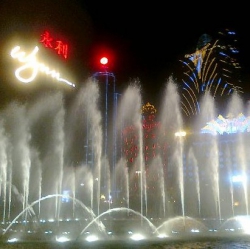Wynn Resorts opened its $4.2 billion Wynn Palace casino in Macau this week, which is the Las Vegas casino company’s most expensive development ever. The grand opening of the Wynn Palace occurred on August 22. Chui Sai On, Chief Executive of the Macau Special Administrative Region, presided over the ceremony. Wynn Resorts CEO and founder Steve Wynn also was in attendance.
The Wynn Palace is located on the Cotai Peninsula, about 20 minutes from the center of Macau. The area is home to some of the most lucrative casinos in the world and has become known as the Cotai Strip, in reference to the world famous Las Vegas Strip. It is about 40 miles by ferry from Macau to Hong Kong, China’s other special administrative district.
Steve Wynn: “The Most Beautiful Hotel in the World”
In his opening remarks, Steve Wynn said, “Wynn Palace is arguably the most beautiful hotel in the world, which is a wonderful thing to be able to say. But it is not in London, Paris, New York or Rome. It is in Cotai, in Macau, and sits here for all the world to come and see.”
Speaking proudly of his latest resort, the 74-year old Wynn said, “It’s our gift to the community, to the public. It will be here forever and it’s perhaps unlikely we’ll see a place of this scope and artfulness in our lifetimes again.”
Last Vestiges of Macau’s Gambling Boom
The last pronouncement might sound like bombast, but it has the ring of truth to it. The 2015-2017 wave of integrated resort-casinos being built in Macau were designed before 26 months of decline in the Macau gaming industry. It is fair to say that $4 billion casinos were unlikely to have been planned, if the developers knew the anti-corruption crackdown would have such a withering effect on Macau’s casino industry.
Given that consideration, it is unlikely another such casino is going to be opened in Macau anytime soon — at least after the Las Vegas Sands’ Parisian Macau opens next month and the MGM Cotain opens next year. Wynn Resorts is known for catering to upscale clients, so their resorts are likely to be a bit more lavish (and expensive) than their competitors’ properties.
Performance Lake
The Wynn Palace is set to have an 8-acre Performance Lake and fountain as a centerpiece attraction. Visitors can take air-conditioned Sky Cabs to look at the performances from 90 feet in the air. Shows at the Performance Lake are going to be highlighted with music from China, America, and Europe.
The South and North Lobby Atriums each have massive floral sculptures of a Carousel and Ferris Wheel, each of which comprise 100,000 flowers apiece. The floral sculptures each keep time to music as visitors pass. Thousands of pieces of fine art are going to surround the floral arrays. Some of the art pieces are from the personal collection of Steve Wynn, who is known as an art connisseur. Mr. Wynn often displays his collection in his company’s resorts around the globe.
Wing Lei Palace
Wing Lei Palace is the centerpiece of the dining experience at the Wynn Palace. The resort is going to feature both fine dining and casual dining experiences. Wing Lei Palace is designed by Roger Thomas, the design chief for Wynn Resorts.
Even the less hoity establishments in the club and dining areas have lavish designs. Wing Lei Bar is adorned with a $25 million chandelier which was fashioned in the 18th Century. Nearby is the Wynn Palace Esplanade, a 200,000 square foot retail area which has 50 luxury retail shops.
Wynn Palace Hotel and Spa
Wynn Palace Hotel is a 28-story tower which includes 1,706 rooms, including luxury suites, villas of high rollers, and rooms for the mass market. The hotel area includes Macau’s biggest spa, a convention center, and a world-class fitness area. Many of the most prestigious rooms and areas overlook the Performance Lake.
The Big Turnaround?
Many hope the opening of the Wynn Palace and Parisian Macau is going to signal a recovery for Macau’s gambling industry. The loss of the junket operators’ VIP high roller industry caused a historic decline in Macau’s revenues. At a time, the city generated 7 times the gaming revenue Las Vegas does every year. Even now, Macau collects more than 3.5 times what Las Vegas does, though 60% of the Vegas Strip’s revenue comes from non-gaming sources these days.
The same cannot be said for Macau. Lawrence Ho of Melco-Crown said last year that Asians love to gamble and Macau could never be like Las Vegas, where non-gaming amenities dominate. If so, that leaves the Chinese mass market gambling niche — the massive new Chinese middle class. It is assumed that the developers of resorts like the Parisian, MGM Cotai, and Studio City had time to build with the mass market in mind. If so, then this last wave of openings might signal a turnaround.
Not everyone is optimistic. Macau’s officials have said they want to see no more than a 3% yearly increase in revenues. They have taken steps to assure no more growth happens, such as limiting gaming tables. Such throttling of casino revenues would seem mad in the United States, but Macau officials have good reason to do so. Chinese President Xi Jinping signaled to Macau it needs to diversify in a December 2014 speech. To have a conspicuous increase of revenues would be to defy the Chinese premier.

